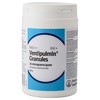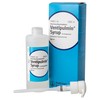Ventipulmin
Ventipulmin for Horses is a treatment for respiratory diseases in horses where bronchospasms and/or mucus accumulation is a contributing factor to an obstruction of the airway. It is particularly beneficial in some allergic respiratory diseases and can be useful in cases where an infection of the respiratory tract is involved.
Ventipulmin is available as a syrup or as granules.
Ventipulmin Granules 500g
£61.96Ventipulmin Granules are widely used for the treatment of respiratory disease in horses where an obstruction of the airway due to bronchospasms and/or mucus accumulation is a contributing...[More info]
Ventipulmin Syrup 355ml
£54.95Ventipulmin Syrup is indicated for the treatment of respiratory diseases in horses where airway obstruction due to bronchospasms and/or mucus accumulation is a contributing factor. Using...[More info]
Contra-indications, warnings, etc
Do not use in cases of known hypersensitivity to the active ingredient. Do not use in horses with known cardiac disease.
Special precautions to be taken by the person administering the veterinary medicinal product to animals
This product contains clenbuterol, a beta-agonist.
Take care to avoid skin contact. In case of skin contact wash affected area thoroughly. If irritation occurs/persists seek medical advice. Take care to avoid accidental eye contact. In the case of accidental eye contact, flush thoroughly with clean water and seek medical advice. When using do not eat, drink or smoke. Wash hands thoroughly after using the product.
Clenbuterol may cause side effects such as sweating (mainly neck region), muscle tremor, tachycardia, slight hypotension or restlessness. These are typical for β-agonists and occur rarely.
If used during pregnancy, treatment must be discontinued at the expected time of delivery since uterine contractions may be abolished under its influence.
Ventipulmin antagonises the effects of prostaglandin F2α and oxytocin. Ventipulmin is antagonised by β-adrenergic blocking agents.
Dosages of clenbuterol hydrochloride up to 4 times the therapeutic dose (administered orally) for a period of 90 days caused transient side effects typical for beta2-adrenoceptor agonists (sweating, tachycardia, muscle tremor), which required no treatment. In case of accidental overdose, a β-blocker (such as propranolol) may be used as antidote.
Withdrawal period
Meat and offal: 28 days.
Do not use in animals producing milk for human consumption.
Dosage and administration
For oral use. Administer 4 ml Ventipulmin Syrup per 125 kg bodyweight twice daily.
This is equivalent to twice daily administration of 0.8 micrograms clenbuterol hydrochloride per kg bodyweight. The syrup should be added to the feed. (One depression of the pump delivers 4 ml syrup). Treatment should continue for as long as necessary.
Further information
Pharmacotherapeutic group: Adrenergics for systemic use (selective beta2-adrenoreceptor agonists)
ATC Vet code : QR03CC13: Drugs for obstructive airway disease.
Pharmacodynamic properties
Ventipulmin contains clenbuterol hydrochloride, which is a sympathomimetic amine which preferentially binds to β2 adrenoreceptors on cell membranes of the bronchi. This subsequently activates the enzyme adenylate cyclase in smooth muscle cells, thus providing intense bronchodilating properties and decreasing airway resistance with minimum effect on the cardiovascular system. Ventipulmin has been shown to inhibit histamine release from mast cells in the lungs, and enhance mucociliary clearance in horses.
Pharmacokinetic particulars
After oral administration in horses, clenbuterol is readily absorbed and maximum plasma concentrations reached within 2 hours of dosing. Steady state level in plasma is reached after 3-5 days treatment and range from 1.0 – 2.2 ng/ml.
The substance is rapidly distributed in tissues and metabolised primarily by the liver. Clenbuterol is the main excretory product and approximately 45% of the dose is eliminated unchanged in the urine. The kidneys excrete 70 – 91% of the total dose, and the remainder is eliminated in the faeces (6 – 15%).

